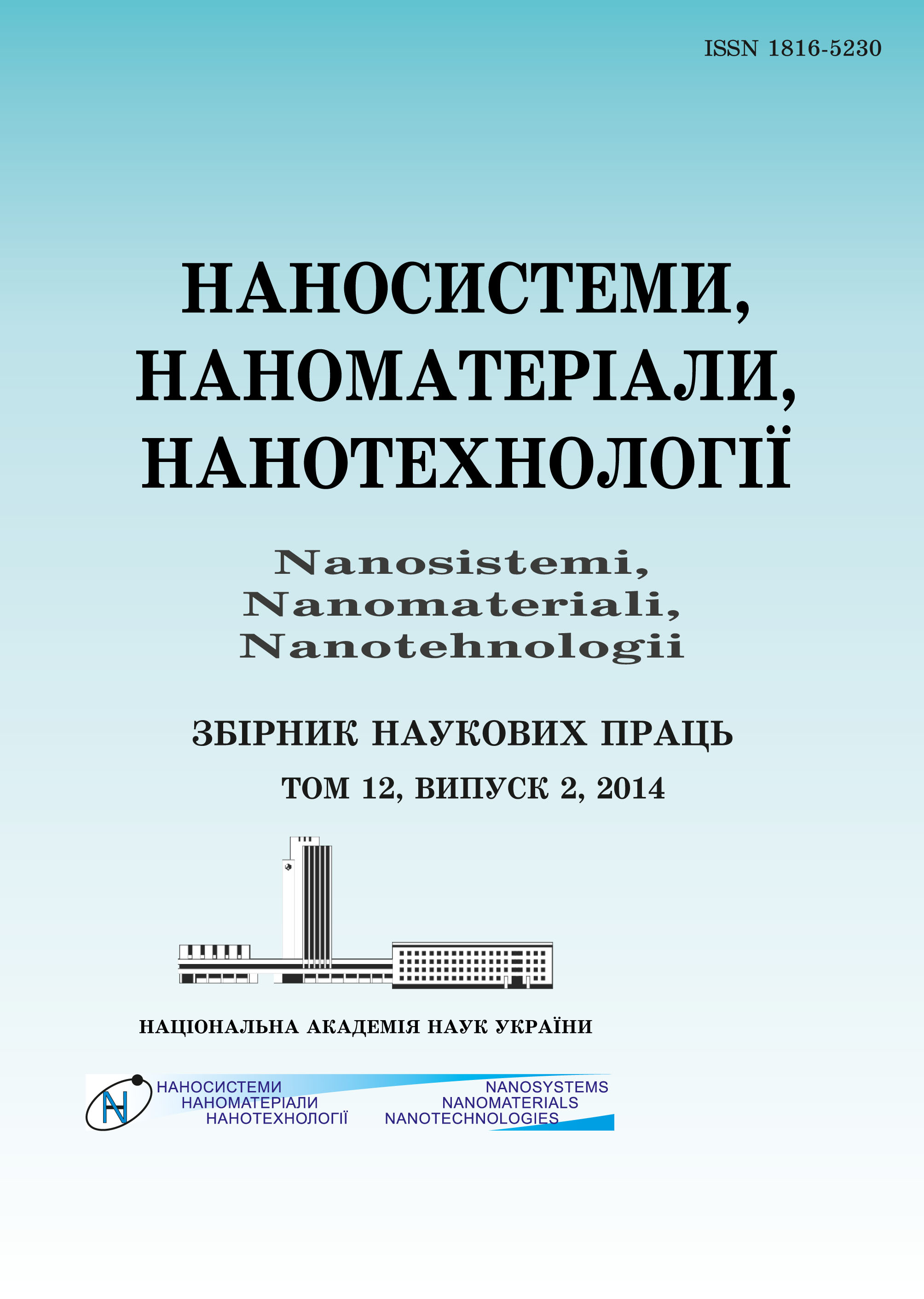|
|
|||||||||
 |
Year 2021 Volume 19, Issue 1 |
|
|||||||
|
|||||||||
Issues/2021/vol. 19 /Issue 1 |
Iryna Ivanenko, Tetiana Dontsova
«Synthesis and Adsorption Properties of Multiwalled Carbon Nanotubes»
0201–0214 (2021)
PACS numbers: 61.48.De, 68.35.Dv, 68.37.Og, 68.43.Mn, 68.43.Nr, 81.15.Gh, 81.65.-b
Multiwalled carbon nanotubes (MWCNTs) were synthesized by carbon vapour deposition method onto the Mo, Fe/MgO catalyst, which was prepared with a precipitation method. The synthesis was carried out at four different temperatures: 600, 700, 800, and 900\(^{\circ}\)C. It was found that the yield of carbon nanotubes increases in proportion to the increase of the synthesis temperature. For purification from catalyst residues and amorphous impurities, as-grown carbon nanotubes were treated with nitric acid (1:1) at boiling for 1 hour with subsequent washing with distilled water. Abundance of catalyst residues after such a treatment decreased from 35–70% to 2–6% that was established with complex thermal analysis. High-resolution transmission electron microscopy indicated that the length and diameter of the obtained multiwalled nanotubes vary depending on the temperature of their synthesis. It was concluded, as the higher temperature of synthesis is, the greater the length and diameter of produced carbon nanotubes are in these experimental conditions. The porous structure of both series of synthesized samples (initial as-grown and washed ones) was studied by the method of low-temperature adsorption–desorption of nitrogen. The obtained isotherms of nitrogen adsorption–desorption indicated that the synthesized samples demonstrate similar adsorption properties. The isotherms of all carbon nanotubes belong to the III type according to Brunauer classification, except the first washed sample, which demonstrated the isotherm of the II type. The pore diameter distributions, which were obtained by mathematical processing the adsorption isotherm with DFT method, discovered that the samples are characterized by the almost complete absence of micro- and mesopores, while macropores exist in a wide range of diameters from 5 to 30 nm. The adsorption properties of the obtained MWCNTs were determined through adsorption of two dye types: cationic methylene blue and anionic Congo red from model aqueous solutions. The initial unwashed nanotubes illustrated the high affinity towards the anionic type dye and the almost complete absence of affinity to the cationic dye; moreover, their adsorption capacity does not depend on the temperature, at which they were obtained. The washed carbon nanotubes exhibit the opposite behaviour; they do not adsorb anionic dye at all, but they actively adsorb cationic dye, and their adsorption activity decreases with increasing temperature of their synthesis.
Keywords: multiwalled carbon nanotubes, synthesis, adsorbent, dye
https://doi.org/10.15407/nnn.19.01.201
References
1. I. Hasanzadeh and M. J. Eskandari, Surf. Coat. Techn., 381: 125109 (2020); https://doi.org/10.1016/j.surfcoat.2019.1251092. X. Li, W. Chen, and Ch. Zou, Pow. Techn., 361: 957 (2019); https://doi.org/10.1016/j.powtec.2019.10.106214Iryna IVANENKO and Tetiana DONTSOVA
3. M. Matandabuzo and P. A. Ajibade, J. Molec. Liq., 296: 111778 (2019); https://doi.org/10.1016/j.molliq.2019.111778
4. J. Dou, D. Gan, Q. Huang, M. Liu, J. Chen, F. Deng, X. Zhu, Y. Wen,X. Zhang, and Y. Wei, Int. J. Biol. Macromol., 136: 476 (2019);DOI: 10.1016/j.ijbiomac.2019.06.112
5. M. Kurkowska, S. Awietjan, R. Kozera, E. Jezierska, and A. Boczkowska,Chem. Phys. Lett., 702: 38 (2018); https://doi.org/10.1016/j.cplett.2018.04.056
6. O. A. Shabaan, H. S. Jahin, and G. G. Mohamed, Arab. J. Chem., 13, No. 3:4797 (2020); https://doi.org/10.1016/j.arabjc.2020.01.010
7. P. M. Lutsyk, P. Shankar, A. G. Rozhin, and S. A. Kulinich, Surf. Interf.,17: 100363 (2019); https://doi.org/10.1016/j.surfin.2019.100363
8. Y. Zhang, Y. Dang, X. Lin, K. An, J. Li, and M. Zhang, J. Chrom. A,460939 (2020); https://doi.org/10.1016/j.chroma.2020.460939
9. B. Verma and C. Balomajumder, Envir. Techn. Innov., 17: 100596 (2019); https://doi.org/10.1016/j.eti.2019.100596
10. Y. Xu, Y. Zhang, D. Zhang, J. Ma, W. Yi, J. Zhang, and H. Shi, J. EnergyStor., 26: 100995 (2019); https://doi.org/10.1016/j.est.2019.100995
11. E. A. Burakova, T. P. Dyachkova, A. V. Rukhov, E. N. Tugolukov,E. V. Galunin, A. G. Tkachev, A. A. Basheer, and I. Ali, J. Mol. Liq., 253:340 (2018); https://doi.org/10.1016/j.molliq.2018.01.062
12. G. Defu, L. Meiying, H. Hongye, C. Junyu, and D. Jibo, J. Molec. Liq., 271:246 (2018); https://doi.10.1016/j.molliq.2018.08.079
13. K. Zare, H. Sadegh, R. Shahryari-ghoshekandi, B. Maazinejad, V. Ali,I. Tyagi, Sh. Agarwal, and V. K. Gupta, J. Molec. Liq., 212: 266 (2015); https://doi.org/10.1016/j.molliq.2015.09.027
14. T. Ahamad, Mu. Naushad, G. E. Eldesoky, S. I. Al-Saeedi, A. Nafady,N. S. Al-Kadhi, A. H. Al-Muhtaseb, A. A. Khan, and A. Khan, J. Molec.Liq., 282: 154 (2019); https://doi.org/10.1016/j.molliq.2019.02.128
15. T. Zhao, X. Li, Y. Wang, J. H. S. Lee, and H. Yan, Mater. Res. Bull., 102:153 (2018); https://doi.org/10.1016/j.materresbull.2018.02.033
16. J. H. Lehman, M. Terrones, E. Mansfield, K. E. Hurst, and V. Meunier,Carbon, 49: 2581 (2011); https://doi.10.1016/j.carbon.2011.03.028
17. Q. Gao, F. Wu, J. Hu, W. Chen, X. Zhang, X. Guo, B. Wang, and X. Wang,Sci. Tot. Envir., 716: 137017 (2020); DOI: 10.1016/j.scitotenv.2020.137017
18. A. Mohammadi and P. Veisi, J. Envir. Chem. Engin., 6, No. 4: 4634 (2018); https://doi:10.1016/j.jece.2018.07.002
19. I. Kosogina, I. Astrelin, G. Krimets, and N. Vereshchuk, Chem. Chem. Tech-nol., 8, No. 3: 365 (2014); https://doi.org/10.23939/chcht08.03.365
20. G. Diao, H. Li, H. Liang, I. Ivanenko, T. Dontsova, and I. Astrelin, NANO:Brief Reports and Reviews, 13, No. 4: 1850036 (2018); https://doi.10.1142/S1793292018500364
 This article is licensed under the Creative Commons Attribution-NoDerivatives 4.0 International License ©2003—2021 NANOSISTEMI, NANOMATERIALI, NANOTEHNOLOGII G. V. Kurdyumov Institute for Metal Physics of the National Academy of Sciences of Ukraine. E-mail: tatar@imp.kiev.ua Phones and address of the editorial office About the collection User agreement |